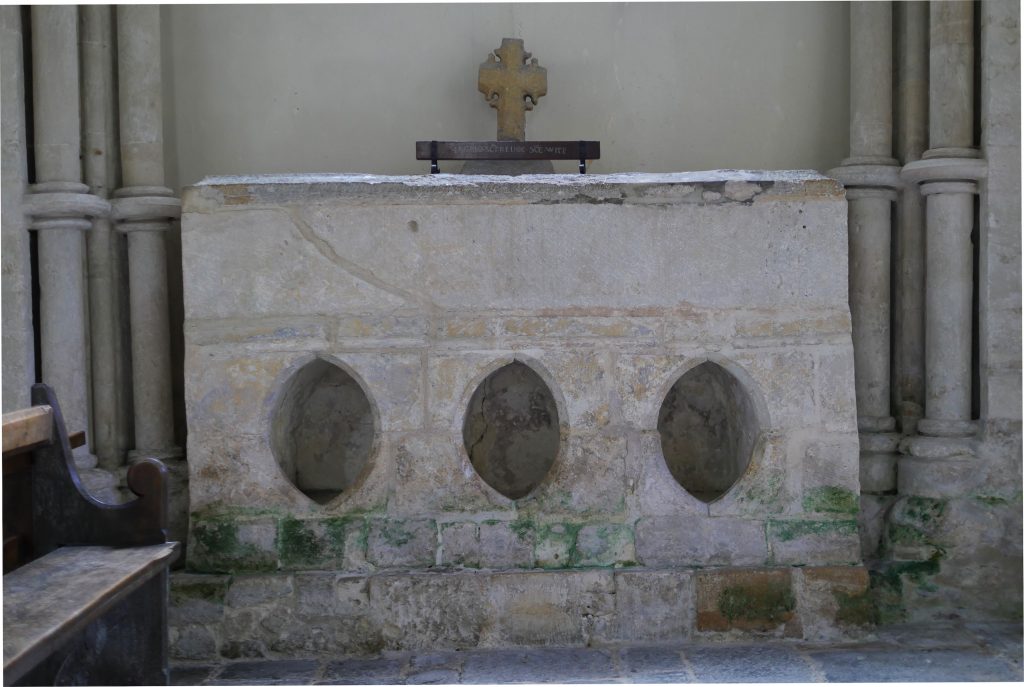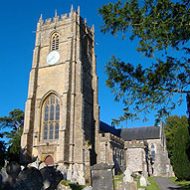Pilgrims have been travelling to the church for hundreds of years…
Photo credit: Sara Hudston
The church in Whitchurch Canonicorum has always been of importance, mentioned by kings since the 9th century.
Although the shrine itself dates from the 13th century, the relics of St Wite within could well be considerably older. Possibly they were the reason the very first wooden building was erected. Legend says that St Wite was buried originally in Charmouth Forest. Her remains were later moved to Whitchurch, where King Alfred ordered that a church be built.
Pilgrims have been travelling to the ‘Cathedral of the Vale’ for hundreds of years. In medieval times, the highway from Bridport to Axminster went through Whitchurch Canonicorum and all local footpaths led here. The Shave Cross Inn, approximately two miles from the church, provided sustenance for pilgrims and perhaps a place where monks could have their tonsures shaved before continuing on their way to the shrine.
The sick and the dying would have been carried into the church to place their diseased limbs in the openings in the shrine and pray for healing. Lepers were not allowed inside but may have been able to touch the shrine from the outside through holes in the wall.
In 1538, Henry VIII banned pilgrimages and the veneration of saints as part of the Reformation of the English church. Most shrines were destroyed and the relics burned and scattered. Only two shrines survived with their relics intact – the shrine of King Edward the Confessor in Westminster Abbey, and St Wite’s here in Whitchurch. No one knows how, or why, St Wite’s shrine escaped destruction, either during the Reformation, or a century later amid the ravages of the English Civil War.
Today people still make their pilgrimages to the shrine to pray for the sick and many believe that St Wite has helped them.

Please consider making a donation to support St Candida and Holy Cross.
The Guest House by Rumi This being human is a guest house. Every morning a new arrival. A joy, a depression, a meanness, Some momentary awareness comes as an unexpected visitor. Welcome and entertain them all! Even if they’re a crowd of sorrows, Who violently sweep your house Empty of its furniture, Still, treat each guest honourably. He may be clearing you out For some new delight. The dark thought, the shame, the malice, Meet them at the door laughing, And invite them in. Be grateful for whoever comes, Because each has been sent As a guide from beyond
God's Dream by Charles Peguy The French poet, expressed this dream of God as the heart of the matter of all Christian ministry I will dream a dream within you….. Good dreams come from me, you know……. My dreams seem impossible, not too practical, not for the cautious man or woman…… a little risky sometimes, a trifle brash perhaps……. Some of my friends prefer to rest more comfortably, in sounder sleep, with visionless eyes…… But, from those who share my dreams I ask a little patience, a little humour, some small courage, and a listening heart…….. I will do the rest……. Then they will risk and wonder at their daring….. Run…and marvel at their speed…. Build… and stand in awe at the beauty of their building…. You will meet me often as you work…. in your companions, who share the risk…. in your friends, who believe in you enough to lend their own dreams their own hearts to your building…. In the people who will stand in your doorway, stay awhile, and walk away knowing that they, too, can find a dream There will be sun-filled days, and sometimes it will rain…… a little variety… both come from me. So come now be content It is my dream you dream…. my house you build…. my caring you witness…. my love you share and this is the heart of the matter. May God who guides our feet into the way of peace go with us on our pilgrim way, that we may serve God in His people day by day And may the blessing of God Almighty, the Father, The Son and the Holy Spirit be with us always Amen
References:
‘A Guide to the Church of Saint Candida and Holy Cross, Whitchurch Canonicorum, Dorset, ‘The Cathedral of the Vale’, Church Guide and History, Edited and Augmented version of that written by Canon G. V. Syer, June 1981, Cynthia Bain, research and revision, John Bain and Tricia Hawkins, Editing, 2005
‘Who Was St Wite’, The Saint of Whitchurch Canonicorum, by Christine Waters, 1980
Henry VIII and the Reformation https://www.history.com/topics/british-history/henry-viii
